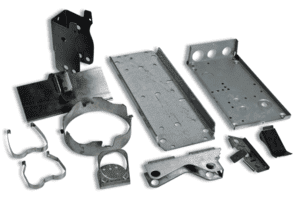At ESI, we deeply understand the unique demands of our clients' industries and are dedicated to helping them reduce costs on their stamped metal parts without compromising quality. With over 30 years of experience, we’ve continuously evolved our engineering solutions and manufacturing capabilities, leveraging advanced automated systems to deliver high-quality results. Our expertise is largely built on supplying safety-critical components to automotive customers, where precision, speed, and efficiency are non-negotiable.
When it comes to stamped metal parts, there are several key areas you can assess and optimize to cut costs effectively. Here are three major factors to consider:
Material Selection
The choice of material plays a huge role in the cost of metal stamping. Even small changes in material properties can significantly impact production time and expenses. For example, harder materials require more force and energy to stamp, which increases both time and cost. By choosing a softer or less abrasive material that still meets your quality standards, you can achieve substantial savings. Some materials may have similar performance characteristics but differ greatly in price, making them excellent alternatives for cost optimization.
It’s also worth noting that market conditions can influence material prices. If your original design was based on a specific material due to its unique properties, but your current requirements have changed, switching to a more cost-effective option could be a smart move. Always evaluate the functional needs of your part before making any material changes.
Tooling Design and Maintenance
Another critical area to review is your tooling requirements. Even minor design changes can lead to significant cost and time variations during production. For instance, square holes typically require more complex machining than round ones, increasing both tooling complexity and expense. Simplifying your design where possible can help reduce these costs while maintaining functionality.
Additionally, analyzing features that cause frequent downtime or wear on your stamping tools is essential. Complex notches or sharp edges can accelerate die fatigue and lead to cracks if not properly maintained. If such features are necessary, implementing a more rigorous maintenance schedule can prevent costly failures. It’s also wise to work closely with your manufacturer to ensure that your tooling design supports long-term efficiency and reliability.
Production Volume and Planning
As demand for your components increases, optimizing for higher production volumes becomes a strategic priority. Larger orders often allow for design improvements that enhance manufacturability and reduce overall costs. If you’re using prototype designs, now is the time to explore opportunities for simplification that maintain function while lowering expenses.
Material and finishing costs can vary widely depending on the volume you purchase. One effective strategy is to place blanket orders over a set period, releasing smaller quantities at regular intervals. This approach can lead to better pricing and more predictable supply chains.
Reviewing complex features for potential revisions not only improves quality control but also extends the life of your tooling between maintenance cycles. Understanding your Estimated Annual Usage (EAU) helps determine the most cost-effective tooling options, including multi-cavity molds, which can boost productivity and reduce per-unit costs.
Finally, adjusting the material thickness or switching to a more malleable metal can also contribute to cost savings. Thinner materials may reduce material costs and extend die life, especially when used in high-volume applications. However, always ensure that any material change maintains the structural integrity and performance of your final product.
Conclusion
Reducing the cost of stamped metal parts doesn’t mean sacrificing quality. By carefully reviewing your materials, tooling design, and production planning, you can achieve significant savings while maintaining high standards. At ESI, we specialize in delivering cost-effective metal stamping solutions that meet your exact specifications and industry requirements.
Whether you're looking to optimize an existing design or start from scratch, our team is here to guide you through every step of the process. Contact us today to request a custom quote and discover how we can help you save money without compromising on quality.
PEGylated biopolymers include carbohydrates, hyaluronic acid, polyamino acid, PEI and others. PEGylated biodegradable polymers can be used for drug delivery with controlled release, microencapsulation, drug solubility enhancement and other biomedical applications including implants, tissue scaffolding, films and others. Biodegradable polyesters including those made of caprolactones have been approved for clinical uses. We provide diblock (A-B) and triblock (A-B-A) copolymers of PEG with PLA (polylactic acid or polylactide), PLGA (polylactic acid-co-glycolic acid or polylactide-co-glycolide), and PCL (polycaprolactone). We also offer custom synthesis services for PEGylated copolymers with other biodegradable blocks of various molecular weights, and with reactive functional groups.
Polyethylene Glycol,Polyethylene Glycol 20000,Polyethylene Glycol Miralax,Polyethylene Glycol Allergie
Liaoning Kelong Fine Chemical Co.Ltd. , https://www.kelongchemy.com

Comments are closed